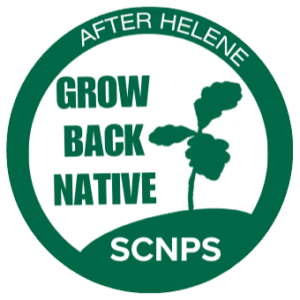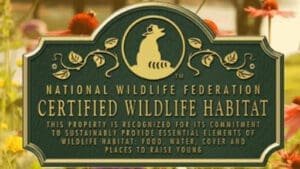by Doug Lockard
Warmer summers, a protracted frigid winter, and destructive hurricanes – this unique set of circumstances in the Upstate presents landowners with the opportunity for a fresh perspective on the upcoming 2025 planting season.
Climate change has moved the needle on our Upstate USDA Hardiness Zones to warmer, while the coldest winter we’ve had in four decades caught us by surprise. Hurricane Helene not only felled thousands of canopy trees and opened up well-shaded landscapes to direct sunlight, it also destroyed nursery inventories and stock for sale across the South.
Fortunately, gardeners and landscapers are, by nature, optimists. How much more optimistic do you have to be than planting a seed in the ground and expecting it to overcome all the forces of nature to survive and thrive?
Yes, this year’s going to be a tough one, but it’s also ripe with opportunities to make dynamic changes to our landscapes that add beauty and introduce greater diversity that benefits not only our property but our community of life in the Upstate.
Resources for Spring Landscaping
Backyard Habitat Certification: Consider aligning your goals with one of several excellent habitat certification programs. Go ahead and learn about these programs right away. Then you can set your own goals on your own schedule for achieving certification or simply improving the positive impact of your plants on our ecosystem.
Each of these programs gives you tips and knowledge to plant responsibly with native species: Clemson’s Carolina Yards, Audubon’s Backyard Habitat , National Wildlife Federation’s Native Plant Habitats , and National Garden Clubs’ Certified Wildlife Habitat.
Climate Change: Learn your Plant Hardiness Zone and stay aware of trends. The Upstate has grown quite a bit warmer in the past decade, a trend that’s expected to continue. Visit the USDA website to learn your ‘current’ zone by typing in your zip code.
Soil Testing & Conditioning: For new homeowners in new ‘developments,’ one of the most important things to consider for new plantings is soil testing and conditioning. Unfortunately, too many developers begin their projects by scraping off centuries of rich topsoil, leaving only nutrient-deficient soil. Learn more from the experts at Clemson Extension Service about how you can conduct soil testing and soil conditioning.
Grow Back Native: ‘Native’ plants are known to have been present prior to arrival of Europeans in America and to have evolved with the land and climate over the millennia. As such, they are the hardiest for our region, tend to require little in the way of inorganic maintenance, and play a vital role in supporting wildlife and protecting the land they coexist with.
 Hurricane Helene destroyed many of our local native trees and shrubs that provided food and shelter to birds, pollinators, and other animals; helped prevent soil erosion; reduced air pollution; absorbed carbon and reduced temperatures – just to name a few of the services these now missing native plants provided. Help fill the service gap from their loss by joining the Grow Back Native Movement. All you have to do is: Choose natives to replace or expand the plantings in your landscape, and encourage friends, family, neighbors and local organizations to do the same.
Hurricane Helene destroyed many of our local native trees and shrubs that provided food and shelter to birds, pollinators, and other animals; helped prevent soil erosion; reduced air pollution; absorbed carbon and reduced temperatures – just to name a few of the services these now missing native plants provided. Help fill the service gap from their loss by joining the Grow Back Native Movement. All you have to do is: Choose natives to replace or expand the plantings in your landscape, and encourage friends, family, neighbors and local organizations to do the same.
Finding Native Plants: True natives can be difficult to find, and too often, those few found in commercial nurseries over great distances aren’t the same genotype as those grown here.
One of the most important horticultural contributions we make to our local ecosystem is the SCNPS Upstate Native Nursery (UNN), which produces the greatest diversity of native plants in our region. Thousands of plants representing hundreds of species of trees, flowering shrubs, perennials, vines, ferns, and groundcovers from the UNN are offered at our spring and fall sales. Mark your calendar for the 2025 Upstate Spring Native Plant Sale on April 12th. Dozens of volunteers will be there to help with your selections, which in many cases, you could not have found anywhere else!
Biodiversity and the Living Landscape: We know so much more today about the benefits of biodiversity, and how the selection of plants in our landscapes can benefit the environment in our yard, our community and our region. The Piedmont Master Gardener’s “Keystone” Native Plants 101 is a great place to start learning about Keystone Plants, and the National Wildlife Federation is a great resource for these most productive native plants that support the most productive species.
Invasive Species: The disruption of natural landscapes, as we experienced in the aftermath of Hurricane Helene, is an invitation for uninvited guests. When you are planning for spring planting, take an inventory of your plants and identify any invasive or non-native species you can remove and replace with native plants. Learn more about problem plants to avoid from the SCNPS’s Invasive Plant Species page with articles about and resources for identifying non-native and invasive plants.
Longevity: A happy tree can live hundreds of years; however, the average newly planted urban tree only lives about 15 years. The most important way to improve your odds is by selecting the right plant for the right place; and native plant species suited for our zone and the sun, water and soil conditions on our property. The second way is to follow the correct planting technique. Visit Trees Upstate’s excellent video on best practices on tree and shrub planting, and while you’re there, register for their annual free trees.
We’ll leave you with one final and invaluable resource: a list of native plant finders!
Have fun dreaming of the new beginnings you’ll soon be planting!
Native Plant Finders:
- The SCNPS/Clemson Cooperative Extension Interactive Native Plant Directory
- SCNPS Native Plant List
- Hometown National Park
- Flowering natives zone 7 & 8
Keystone Plants – the most valuable for our ecosystem:



